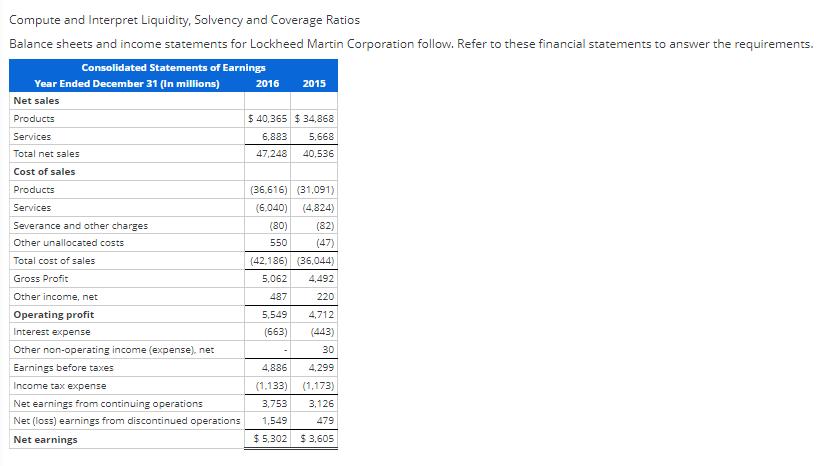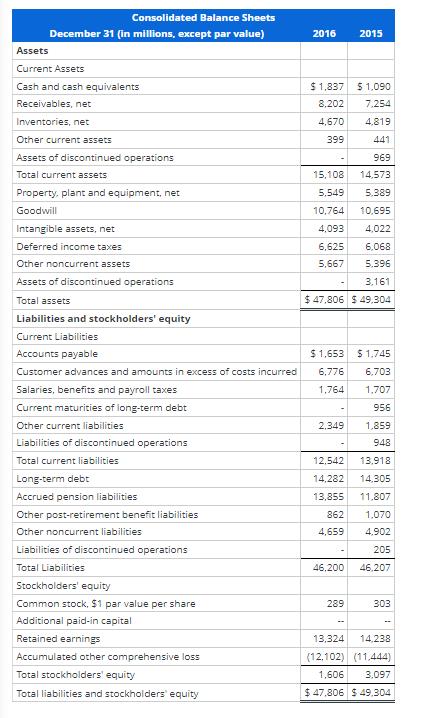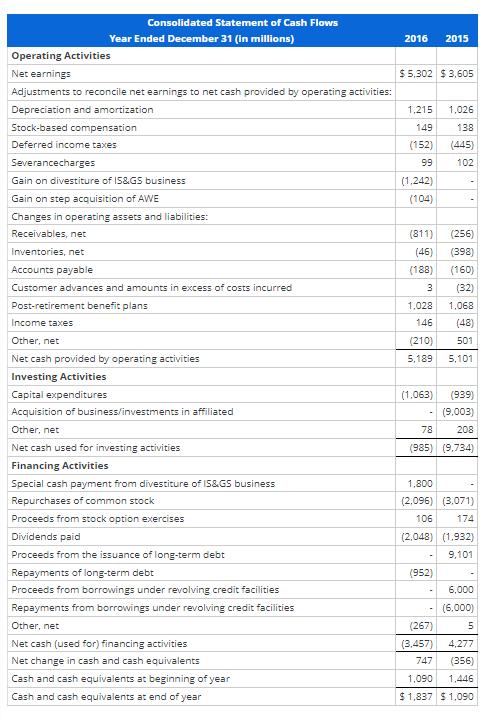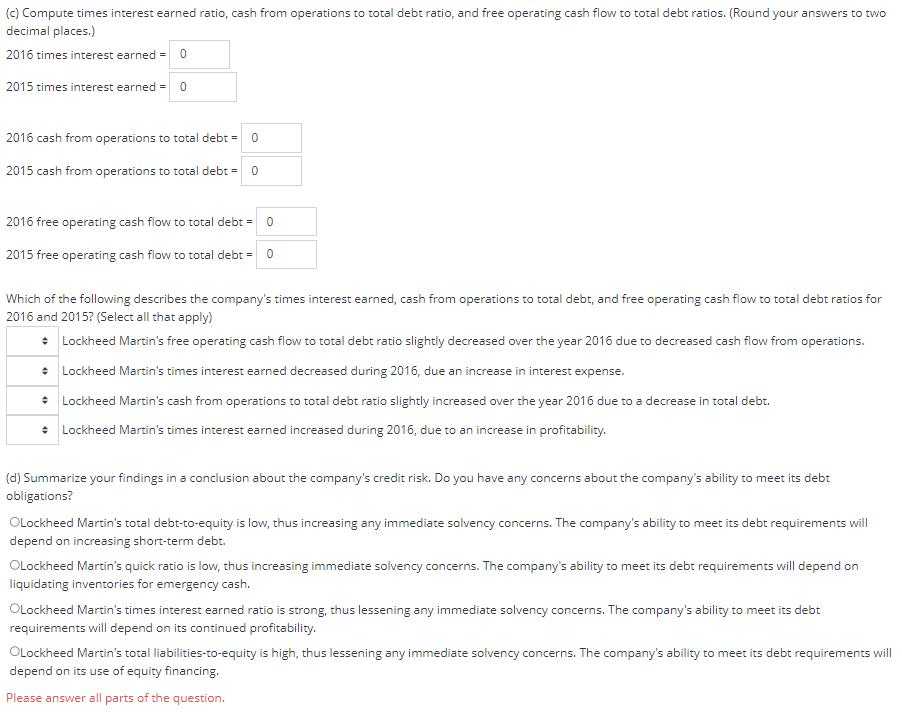Answered step by step
Verified Expert Solution
Question
1 Approved Answer
Compute and Interpret Liquidity, Solvency and Coverage Ratios Balance sheets and income statements for Lockheed Martin Corporation follow. Refer to these financial statements to





Compute and Interpret Liquidity, Solvency and Coverage Ratios Balance sheets and income statements for Lockheed Martin Corporation follow. Refer to these financial statements to answer the requirements. Consolidated Statements of Earnings Year Ended December 31 (In millions) 2016 Net sales Products Services Total net sales Cost of sales Products Services Severance and other charges Other unallocated costs Total cost of sales Gross Profit Other income, net Operating profit Interest expense Other non-operating income (expense), net Earnings before taxes Income tax expense Net earnings from continuing operations Net (loss) earnings from discontinued operations Net earnings 2015 $ 40,365 $34,868 6,883 5,668 47,248 40.536 (36,616) (31,091) (6,040) (4,824) (80) 550 (82) (47) (42,186) (36,044) 5,062 4,492 487 5,549 (663) 220 4,712 (443) 30 4,886 4,299 (1.133) (1,173) 3,753 3,126 1,549 479 $5,302 $3,605 Consolidated Balance Sheets December 31 (in millions, except par value) Assets Current Assets Cash and cash equivalents Receivables, net Inventories, net Other current assets Assets of discontinued operations Total current assets Property, plant and equipment, net Goodwill Intangible assets, net Deferred income taxes Other noncurrent assets Assets of discontinued operations Total assets Liabilities and stockholders' equity Current Liabilities Accounts payable Customer advances and amounts in excess of costs incurred Salaries, benefits and payroll taxes Current maturities of long-term debt Other current liabilities Liabilities of discontinued operations Total current liabilities Long-term debt Accrued pension liabilities Other post-retirement benefit liabilities Other noncurrent liabilities Liabilities of discontinued operations Total Liabilities Stockholders' equity Common stock, $1 par value per share Additional paid-in capital Retained earnings Accumulated other comprehensive loss Total stockholders' equity Total liabilities and stockholders' equity 2016 2015 $ 1,837 $ 1,090 8,202 7.254 4,670 4,819 399 15,108 5,549 10,764 4,093 6,625 5,667 $1,653 3,161 $ 47,806 $ 49,304 2,349 $1.745 6,776 6,703 1,764 1.707 956 1,859 948 441 969 12,542 14,282 13,855 14,573 5.389 862 4,659 10,695 4,022 6.068 5,396 13,918 14,305 11,807 1,070 4,902 205 46,200 46,207 289 303 13,324 14,238 (12,102) (11.444) 1,606 3.097 $ 47,806 $ 49,304 Consolidated Statement of Cash Flows Year Ended December 31 (in millions) Operating Activities Net earnings Adjustments to reconcile net earnings to net cash provided by operating activities: Depreciation and amortization Stock-based compensation Deferred income taxes Severancecharges Gain on divestiture of IS&GS business Gain on step acquisition of AWE Changes in operating assets and liabilities: Receivables, net Inventories, net Accounts payable Customer advances and amounts in excess of costs incurred Post-retirement benefit plans Income taxes Other, net Net cash provided by operating activities Investing Activities Capital expenditures Acquisition of business/investments in affiliated Other, net Net cash used for investing activities Financing Activities Special cash payment from divestiture of IS&GS business Repurchases of common stock Proceeds from stock option exercises Dividends paid Proceeds from the issuance of long-term debt Repayments of long-term debt Proceeds from borrowings under revolving credit facilities Repayments from borrowings under revolving credit facilities Other, net Net cash (used for) financing activities Net change in cash and cash equivalents Cash and cash equivalents at beginning of year Cash and cash equivalents at end of year 2016 2015 $5,302 $3,605 1,215 1,026 149 138 (152) (445) 99 102 (1,242) (104) (811) (256) (46) (398) (188) (160) 3 (32) 1,068 (48) (210) 501 5,189 5,101 1,028 146 (1.063) (939) (9.003) 78 208 (985) (9,734) 1,800 (2,096) (3.071) 106 174 (2,048) (1.932) 9,101 (952) 6,000 (6.000) 5 (267) (3.457) 4,277 747 (356) 1,090 1,446 $1,837 $1,090 (a) Compute Lockheed Martin's current ratio and quick ratio for 2016 and 2015. (Round your answers to two decimal places.) 2016 current ratio = 0 2015 current ratio= 0 2016 quick ratio = 0 2015 quick ratio = 0 Which of the following best describes the company's current ratio and quick ratio for 2016 and 2015? OThe current ratio has increased while the quick ratio has decreased in the period from 2015 to 2016, which suggests the company has a shortage of liquid assets. OBoth the current and quick ratios have decreased from 2015 to 2016 however, the company is liquid. OBoth the current and quick ratios have increased from 2015 to 2016, meaning the company is liquid. OThe current ratio has decreased while the quick ratio has increased from 2015 to 2016, which suggests the company has a shortage of current assets. (b) Compute total liabilities-to-equity ratios and total debt-to-equity ratios for 2016 and 2015. (Round your answers to two decimal places.) 2016 total liabilities-to-stockholders' equity = 0 2015 total liabilities-to-stockholders' equity = 0 2016 total debt-to-equity = 0 2015 total debt-to-equity = 0 Which of the following best describes the company's total liabilities-to-equity ratios and total debt-to-equity ratios for 2016 and 2015? OThe total liabilities-to-equity ratio has decreased while the total debt-to-equity ratio has increased in the period from 2015 to 2016, which suggests the company has decreased the use of short-term debt financing. OThe total liabilities-to-equity ratio has increased while the total debt-to-equity ratio has decreased in the period from 2015 to 2016, which suggests the company has increased the use of short-term debt financing. OBoth the total liabilities-to-equity and total debt-to-equity ratios have increased from 2015 to 2016. These increases suggest that the company is less solvent. OBoth the total liabilities-to-equity and total debt-to-equity ratios have decreased from 2015 to 2016. The difference between these two measures reveals that any solvency concerns would be for the short run.. (c) Compute times interest earned ratio, cash from operations to total debt ratio, and free operating cash flow to total debt ratios. (Round your answers to two decimal places.) 2016 times interest earned = 0 2015 times interest earned = 0 2016 cash from operations to total debt = 0 2015 cash from operations to total debt = 0 2016 free operating cash flow to total debt = 0 2015 free operating cash flow to total debt = 0 Which of the following describes the company's times interest earned, cash from operations to total debt, and free operating cash flow to total debt ratios for 2016 and 2015? (Select all that apply) * Lockheed Martin's free operating cash flow to total debt ratio slightly decreased over the year 2016 due to decreased cash flow from operations. * Lockheed Martin's times interest earned decreased during 2016, due an increase in interest expense. * Lockheed Martin's cash from operations to total debt ratio slightly increased over the year 2016 due to a decrease in total debt. + Lockheed Martin's times interest earned increased during 2016, due to an increase in profitability. (d) Summarize your findings in a conclusion about the company's credit risk. Do you have any concerns about the company's ability to meet its debt obligations? OLockheed Martin's total debt-to-equity is low, thus increasing any immediate solvency concerns. The company's ability to meet its debt requirements will depend on increasing short-term debt. OLockheed Martin's quick ratio is low, thus increasing immediate solvency concerns. The company's ability to meet its debt requirements will depend on liquidating inventories for emergency cash. OLockheed Martin's times interest earned ratio is strong, thus lessening any immediate solvency concerns. The company's ability to meet its debt requirements will depend on its continued profitability. OLockheed Martin's total liabilities-to-equity is high, thus lessening any immediate solvency concerns. The company's ability to meet its debt requirements will depend on its use of equity financing. Please answer all parts of the question.
Step by Step Solution
★★★★★
3.45 Rating (168 Votes )
There are 3 Steps involved in it
Step: 1
a Current ratio Current assets current liabilities 2016 15108 12542 120 2...
Get Instant Access to Expert-Tailored Solutions
See step-by-step solutions with expert insights and AI powered tools for academic success
Step: 2

Step: 3

Ace Your Homework with AI
Get the answers you need in no time with our AI-driven, step-by-step assistance
Get Started


